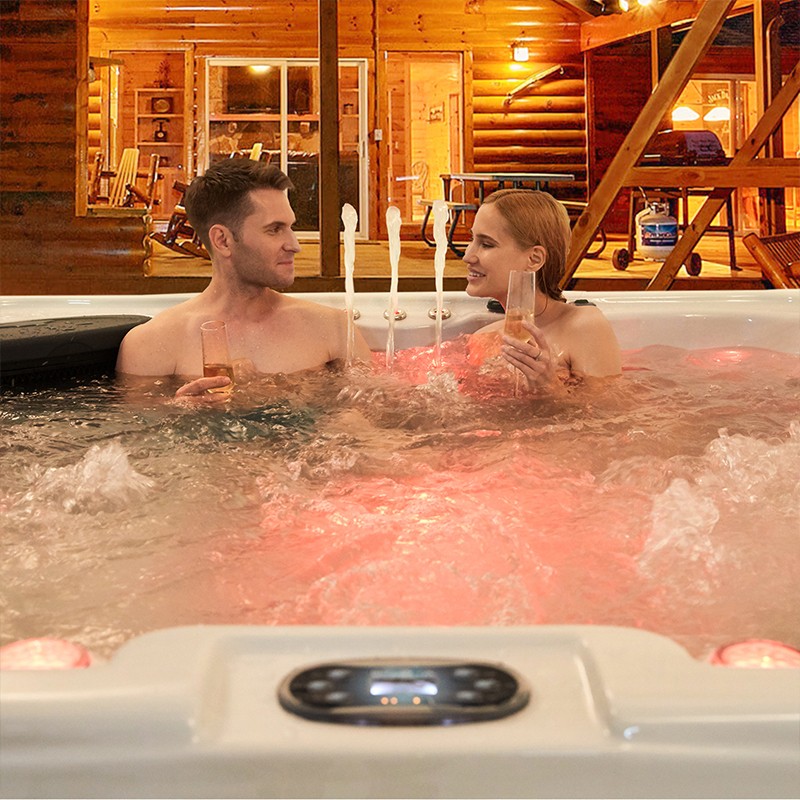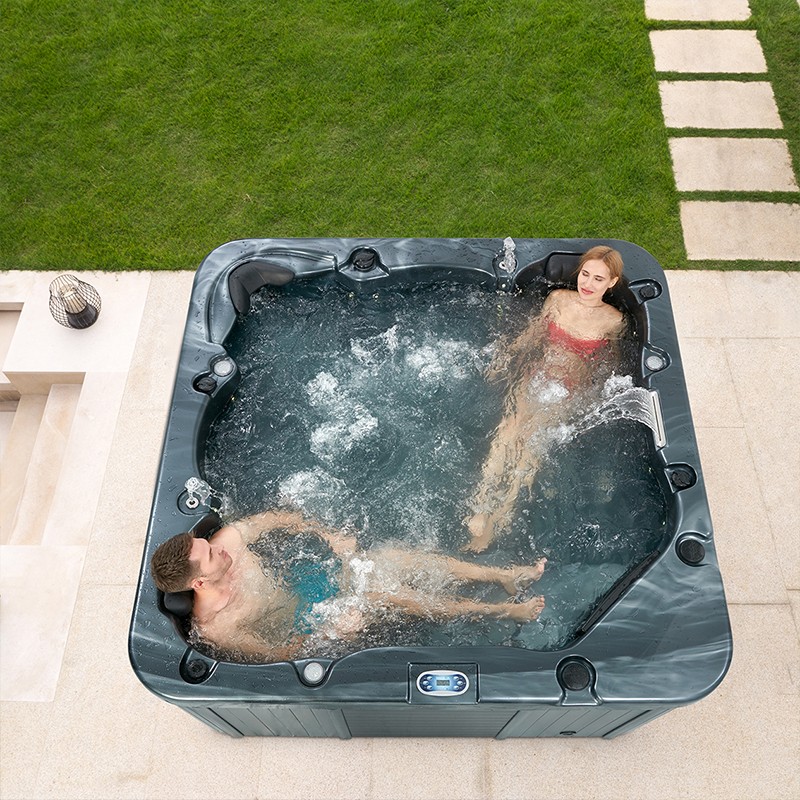
Does whirlpool spa hot tub affect male fertility?
2025-07-19 15:30Does whirlpool spa hot tub affect male fertility? This is not only related to personal health, but also involves the future continuation of the family and population fertility. Therefore, it is crucial to carry out scientific analysis and explanation around this issue.
This article will start from the physiological mechanism of male fertility, combined with the working principle of whirlpool spa hot tub, and systematically analyze factors such as heat exposure, water temperature, bathing time, and sensitivity of sperm production environment.

What is whirlpool spa hot tub?
A whirlpool spa hot tub is a device that uses high-temperature water and jet water (whirlpool) for relaxation and hydrotherapy. It usually consists of the following main parts:
· Heating system: The water temperature is kept between 36°C and 40°C through electric heating or gas;
· Circulating water pump system: The water flows continuously in the bathtub, forming bubbles and vortexes;
· Bubble massage system: Inject air to produce fine bubbles to form a massage effect;
· Temperature control device: Maintain a constant water temperature and provide hot water therapeutic effects for a long time;
· Outdoor/indoor design: It can be installed in an outdoor courtyard or bathroom and is used more frequently.
The high temperature environment and continuous heat exposure of the whirlpool spa hot tub are key factors in discussing whether it affects male fertility.

What is the physiological mechanism of male fertility?
To understand the potential impact of the whirlpool spa hot tub on male fertility, we must first understand the male reproductive physiological process.
1. Function and location of the testicles
The production of male sperm is mainly completed in the testicles. The reason why the testicles are located in the scrotum rather than in the abdominal cavity is that they are extremely sensitive to temperature. The optimal temperature for normal testicular sperm production is about 2°C to 3°C below body temperature (about 34°C to 35°C). Excessively high temperatures will inhibit sperm production and affect sperm quality, motility and morphology.
2. Sperm production cycle
A complete sperm development cycle takes about 64 to 72 days. Any exposure to high temperatures during this period may interfere with sperm formation, reduce total sperm count, motility and fertilization ability.
3. Effects of heat on sperm
Several studies have shown that a 1°C increase in testicular temperature may have an adverse effect on sperm quality. This effect is usually temporary, but if exposed to high temperatures for a long time or repeatedly, it may lead to a persistent decline in spermatogenesis.

Risks of heat exposure in whirlpool spa hot tubs
There is a significant conflict between the use environment of whirlpool spa hot tubs and the temperature sensitivity of sperm production.
1. Water temperature setting
Most whirlpool spa hot tubs are set at a temperature of 37°C to 40°C. Although this temperature is extremely beneficial for muscle relaxation, it is significantly higher than the testicles' suitable sperm production temperature.
2. Soaking time
Users usually soak in the whirlpool spa hot tub for 20 to 40 minutes. In this closed, high-temperature environment, the scrotal temperature will rise rapidly, and the heat dissipation efficiency is much lower than that in the air environment.
3. Equipment closure
Unlike traditional baths or showers, the body is mostly submerged in the water when using the whirlpool spa hot tub. In addition, the heat capacity of water is high, and the heat is continuously and evenly transferred to the body surface and testicle area, making cooling more difficult.
Will the whirlpool spa hot tub affect male fertility?
1. University of California, San Francisco (UCSF) study
In 2007, UCSF conducted a study on 11 men with fertility problems and found that after using the hot tub for at least 30 minutes a week for three months, the number and activity of sperm decreased significantly. After stopping use, 45% of the participants increased their total sperm count by about 491% within 3-6 months.
Although the sample size is small, it is the first time that data has been used to confirm that "wet heat exposure" can have a substantial impact on sperm production and motility. The use of hot tubs for more than 30 minutes per week was set as the research standard.
UCSF research results:
· Within three to six months of stopping the use of whirlpool spa hot tubs and hot baths, 45% of the subjects had significantly improved sperm motility;
· The research conclusion clearly stated: "Long-term hot water baths are a risk factor for reversible male infertility."
2. Relevant reports from WHO and the European Association of Urology
The World Health Organization pointed out:
· Increased ambient temperature is an interventionable risk factor for male infertility;
· The European Association of Urology's "Guidelines for Male Infertility" mentioned: Frequent entry into hot baths or whirlpools should be avoided as much as possible to protect testicular spermatogenesis.
The above studies all support a common view: high temperature exposure can reduce male sperm quality, and whirlpool spa hot tubs provide a typical high temperature exposure environment for this purpose.
Why does hot water exposure affect sperm parameters?
1. Decreased sperm count
High temperature inhibits spermatogonia division and testicular supporting cell function, resulting in a significant decrease in the number of sperm per unit of semen.
2. Decreased sperm motility
After being heated, the mitochondrial dysfunction of the sperm tail leads to poor motility and a reduced probability of fertilization.
3. Increased sperm morphological abnormality rate
Temperature stimulation causes DNA damage, structural distortion, and an increase in the proportion of abnormal sperm, which reduces the sperm fertilization ability.
4. Impact on hormone levels
High temperature can affect the secretion of luteinizing hormone (LH) and follicle-stimulating hormone (FSH), indirectly interfere with testosterone levels, and further affect the spermatogenic environment.

Reversibility of heat exposure risks and clinical recommendations
Fortunately, unlike radiation or chemical exposure, the effects of heat exposure on sperm are mostly reversible.
1. Reversible cycle
A reproductive medicine study pointed out that 3 to 6 months after stopping heat exposure, the sperm parameters of most men can return to baseline levels. It is recommended that men who plan to have children stop using high-temperature bathtubs at least half a year in advance.
2. Clinical recommendations
·If men have infertility tendencies, they should actively avoid using whirlpool spa hot tubs;
·It is relatively safe for healthy men to use 1-2 times a week, no more than 15 minutes each time;
·Try to keep the testicles ventilated and cool;
·Avoid collecting semen for testing immediately after sauna or hot water bath to prevent distortion of results.
Based on the above analysis, we can draw a scientific and rational conclusion:
Yes, whirlpool spa hot tubs may indeed affect male fertility!
This effect mainly comes from the inhibitory effect of high temperature on testicular sperm production, and increases the risk of infertility by reducing sperm count, vitality and morphological health. Although this effect is reversible in most cases, if the whirlpool spa hot tub is used for a long time and frequently without attention, it may lead to persistent fertility problems.
Why is Lovia Spa considered one of China’s top spa brands?
Lovia Spa, under Guangzhou HuanTong Industrial, earned its spot as one of China’s top 5 spa brands in 2019 thanks to its unwavering commitment to quality, innovation, and customer satisfaction. Our vast factory, expert team, extensive certifications, and diverse product line—from spa jacuzzi tubs to swim spas—set us apart from competitors.
We provide attractive prices, wholesale opportunities, manufacturing, and worldwide supply, making us a leader in both domestic and international spa markets.
